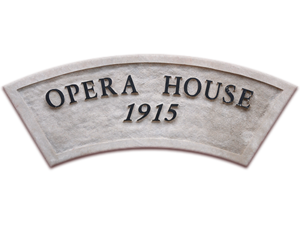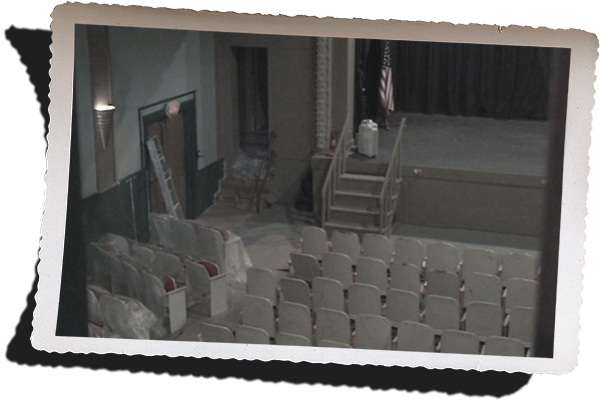The Old Opera House
Coggon and area residents have twice witnessed a dream come true when the “Old Opera House” was renovated and reopened in 1993. The Opera house was first opened in 1915 by citizens with a dream to have a place in Coggon to hold cultural programs and community gatherings.
An item in the Monticello Express of 1914 states the businessmen of Coggon had raised $18,000 for the erection of a new opera house, that would be built to accommodate all public meetings. Loans were advanced and stock was sold at $25 per share. Stock certificates showed A. W. Savage as President and N. B. Richardson as Secretary of the Coggon Opera House Company. The 60 by 100 foot brick structure was built on Main Street. Dr. G. M. Kendall was Manager and Secretary after the Opera House opened.
The grand opening was held Monday, February 8, 1915, with a Grand Minstrel program by Hyperion Lodge of the Knights of Pythias from Manchester, Iowa. A dance followed the performance with tickets costing 50 cents per couple.
Early Years
A scanning of microfilm rolls and copies of old Coggon Monitor newspapers, shows a steady schedule of activities held in the Opera House. During World War I fund-raisers were held by the Red Cross to help support the country in the war effort. One Red Cross benefit color poster for August 20, 1917, featured Alice Joyce in Greater Vitagraph’s Super Photo-Drama, Womanhood, the Glory of A Nation.
Many plays were performed. One advertisement said, “If you need a spring tonic, come; if you don’t, come anyway!” Sometimes a director of note would come and assemble a local cast. A Christmas Carol and Easter Parade were two plays produced this way. A three-act play was given on December 19 & 20, 1924, to benefit St. Luke’s’ Methodist Hospital of Cedar Rapids. The Opera House was the location for high school plays. The faded signatures of cast members and names of plays can still be read on the backstage walls and the backs of old scenery flats found in the Opera House.
High school commencements were held in the Opera House. They had previously been held in the Methodist Episcopal Church. Visiting speaker Philip Penelton addressed one class. His subject was “Solomon and His University.” Commencements were held here until 1936, when a gymnasium was added to the high school. At least two members of that class were glad the ceremony was not too lengthy. While setting up the chairs on stage, the speaker was forgotten in the count. Two seniors were forced to share a chair!
Basket socials and dances were often mentioned in news reports. An ad for a New Year’s Eve basket social in 1920 urged ladies between the ages of 9 to 90 to come, with “gents” bringing their pocket books! There was a Thanksgiving Grand Ball and Festival with Rankins’ five-piece orchestra of Cedar Rapids. In 1921 the local American Legion sponsored a social to earn money for a “home” building.
Other events included a Republican Rally and a health program with questions answered by doctors in attendance. There was a Junior-Senior banquet with “beautifully decorated tables and favors.” The orchestra was curtained off with crepe paper drapes. Lecture series were popular with a season’s ticket providing a variety of entertainment, knowledge and information. A Shipping Association meeting, an implement “Trade Show” and similar events agricultural were also held.
Boys and girls basketball games were held at the Opera House. The front row seats were removed to provide a court. The balcony seats were popular at games and when films were shown. The school paid sums of $20 to $38 for quarterly rent to use the building for games, plays and other events.
In the early 1920’s silent films were shown several nights a week. The titles are interesting to read: Sweet Lavender, High and Dry, The Street Called Straight and Basil King plus All Star Cast. The usual price was 25 to 30¢ for adults; children 10¢, but when seats were reserved, it was 50¢. These movies held audiences of all ages spellbound, as promised in the advertisements.
The Comet Theater
When movie theaters became popular, a large screen and projection booth were added. A contest was held to name the movie house. The winning name “Comet” was chosen and a large sign erected over the marquee and ticket booth. In the 1940’s Bank Nights brought large crowds with the hope of winning a cash prize. Dishes were also awarded at times. Tickets cost 22¢ on Saturday and 28¢ on Sunday, Tuesday and Wednesday. The 28¢ included a special World War II tax. No movies were shown on Friday nights after football was added to the high school schedule.
The Coggon Improvement Company was formed in 1944 and became the building’s owner. They leased it to various movie theater operators through the years. These operators were: Joe C. Smay – 1944-47; Vic Williams – 1947-49; Fay & Mabel French – 1949-74; Russell Schmidt and Dennis Pflughaupt families – 1974-80; Ron & Linda LaPole – 1981-82. When television came, attendance declined. The Comet Theater was closed in 1982. Neglect and vandals took their toll on the structure.
Old Opera House Community Arts Council and Renovation Work
The Old Opera House Community Arts Council was formed in 1989. The group’s goals included the restoration of the Opera House. This fit with their mission to promote the visual arts in Coggon and the surrounding area. A board of directors was elected in May, 1989. Officers were Deb Foster, president; Beverly Hughes, secretary; Denise Pesek, treasurer; and board members Pamela Starr and Phyllis Pflughaupt. Sixteen persons were listed as members. In October, the Arts Council was incorporated as a non-profit organization and in December the Coggon Improvement Company deeded the Opera House building to the council. The current logo was designed by Grace Williamson.
Thus began a four year journey to restore and reopen the Opera House. In 1990, clean-up began. A notice to members said to bring cleaning supplies including dust masks and scoop shovels! The workers will always remember summoning the fire department. A bird’s nest in the outside marquee caught fire when the electricity was turned on.
The seats needed replacement due to damage by mildew and vandals. Replacement seats came from the closed Plaza Theater in Cedar Rapids. Fund-raisers were held to raise money for renovation work. With lots of labor, legal approval and many donations, things began to look hopeful.
In 1993, a concerted effort was made to get the Opera House functional again. Adam Mangold chose the Opera House renovation for his Eagle Scout Award community service project. The Coggon Brass+, a local instrumental group, high school students and members of the Arts Council held a kick-off street dance in June to let area residents know about the work to be done and to solicit arts council memberships and volunteers.
The renovation became a family affair. Mangold, his parents Bill and Jean, and sister Becky persevered throughout the summer to recruit and coordinate the work of volunteers. Over 900 volunteer hours were recorded by 100 persons to accomplish cleaning and renovation. During that summer the ceiling was painted, floors cleaned and painted, seats installed, auditorium walls painted, electrical system reworked, and roof patched to reduce the leaking as much as possible.
The goal was to have the building ready for a Grand Reopening Variety Show on September 18, 1993. A sellout crowd of over 300 attended and were not disappointed. Local talent provided quality entertainment. The greatest thrill for many was just being there again!

